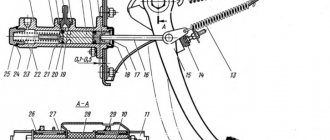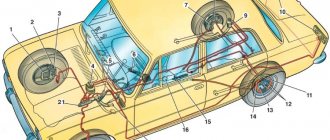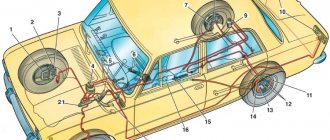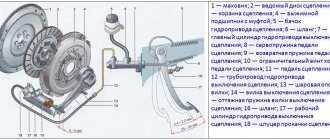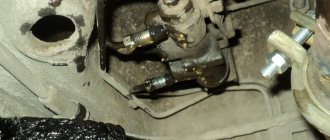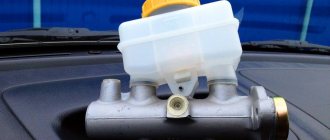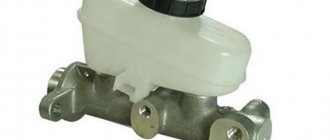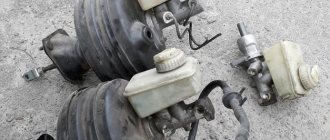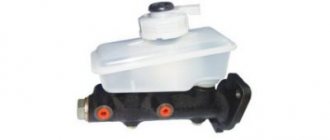If we simplify the formulation of the actions performed by the clutch drive, it will sound like this - the transmission of torque from the motor to the corresponding gearbox shaft with the ability to disable and then softly engage after switching to the desired gear. Nowadays, designers have not yet come up with anything more effective for achieving this goal than a hydraulic clutch drive. The diagram and principle of operation of the described device is simple: a depressed pedal acts on the clutch cylinder rod, which, accordingly, using hydraulic fluid located in the tank through tubes, activates, through the working cylinder, the fork and the release bearing.
Failure of the clutch drive occurs for several reasons, one of which may be a faulty clutch master cylinder; in order to repair it, it is advisable to understand its structure, signs indicating the inoperability of the mechanism, methods of repair, and if repair is not possible, then how to make it replacement.
Clutch master cylinder VAZ 2101
Stable operation of the clutch master cylinder (MCC) has a direct impact on the functioning of the gearbox and its service life, as well as the smoothness of gear shifting. If the hydraulic drive breaks down, control of the gearbox becomes impossible, as does further operation of the vehicle.
What is it for?
The main function of the GCS is to briefly disconnect the power unit from the gearbox when changing gears. When you press the pedal, pressure is created in the system, which acts on the clutch fork rod. The latter drives the release bearing, controlling the clutch.
How it works
The main components of the node are:
- outer cuff;
- sealing collar;
- union;
- stock;
- return spring;
- frame;
- case for protection.
The GCS housing contains a return spring, cuffs, working and floating pistons
Principle of operation
The hydraulic clutch consists of two cylinders - the main and the working (GC and RC). The operating principle of the hydraulic drive is based on the following:
- Liquid enters the GC through a hose from the tank.
- When the clutch pedal is acted upon, the force is transmitted to the rod by a pusher.
- The piston in the main center moves out, which leads to the valve closing and compression of the liquid.
- After the fluid is compressed in the cylinder, it enters the hydraulic system through a fitting and is supplied to the DC.
- The slave cylinder drives the fork, which moves the clutch with the release bearing forward.
- The bearing presses on the friction spring of the pressure plate, releasing the driven disk, after which the clutch disengages.
- After the pedal is released, the cylinder piston returns to its original position under the influence of the spring.
The pedal moves the pusher, which, in turn, moves the piston and creates pressure in the hydraulic drive system
Where is
The GCS on the VAZ 2101 is installed under the hood near the vacuum brake booster and the master cylinder of the brake system. There are also reservoirs near the clutch cylinder: one for the braking system, the other for the hydraulic clutch.
The GCS on the VAZ 2101 is located in the engine compartment near the vacuum brake booster and the master cylinder of the brake system
When is replacement needed?
The cylinder elements wear out over time, which leads to interruptions in the operation of the mechanism. Repair or replacement of the main circulation system is necessary when the following symptoms appear:
- airiness of the system;
- leakage of working fluid;
- wear of cylinder components.
The presence of air in the hydraulic drive system disrupts the performance of the system, making its operation impossible. Air can enter the hydraulic drive through microcracks in the sealing elements of the cylinder or in the connecting hoses. If, when checking the system, a constant lack of fluid in the expansion tank is discovered, you need to inspect the entire clutch mechanism, since fluid can leave not only the master cylinder. If the amount of fluid in the hydraulic drive system is insufficient, the required pressure to move the clutch fork will not be able to be generated. This problem will manifest itself in the inability to separate the engine and gearbox when pressing the clutch pedal. If the leak is caused by wear of the connecting hoses, then replacing them does not raise any special issues. If the problem is related to the GCS itself, then the product will have to be dismantled, disassembled and the cause found out, or simply replaced with a new part.
Partial renovation
Repairing the clutch master cylinder using a repair kit
The first signs of a malfunction should serve as a reason to diagnose the clutch master cylinder and the entire system as a whole. Timely measures taken will allow you to avoid replacing the entire assembly by eliminating the malfunction by replacing worn parts. Repair of the clutch master cylinder is carried out using a repair kit, which includes the following parts:
- Protective cap.
- Retaining ring.
- Piston.
- Return spring.
- Piston cuffs.
Cylinder repair work with installation of a repair kit is carried out in the following order:
- Removing and disassembling the cylinder.
- Flushing with brake fluid (other solvents are prohibited).
- Inspect the cylinder for scoring, condition of the mirror and rod. Minor corrosion and scuffing can be removed with fine-grained sandpaper. Although damage of this type indicates a violation of the gap between the cylinder and the piston.
- Replacement of worn parts provided in the repair kit.
- Before assembling the cylinder, all parts are lubricated with brake fluid, and grease is applied to the spherical surface of the piston in contact with the pusher.
- Assembly and installation of the clutch master cylinder.
- Bleeding the system.
Which one is better to put
On the VAZ 2101 it is necessary to install a hydraulic clutch designed for the VAZ 2101–07. Cylinders designed to work in UAZ, GAZ and AZLK vehicles are not suitable for installation on a “penny” car. The situation is similar with imported analogues. It will be quite problematic to introduce a GVC from any foreign car, which is due to different mounting of the unit, different threads and tube configuration. However, a hydraulic drive from a VAZ 2121 or from a Niva-Chevrolet is suitable for the “classic”.
Manufacturer's choice
Today there are many companies that manufacture clutch master cylinders. However, when choosing and purchasing the unit in question, preference should be given to the following manufacturers:
- JSC AvtoVAZ;
- Brick LLC;
- Kedr LLC;
- Fenox;
- ATE;
- TRIALLI.
When choosing GVCs, it is better to give preference to well-known manufacturers
The average cost of a hydraulic clutch is 500–800 rubles. However, there are products that cost about 1,700 rubles, for example, cylinders from ATE.
Table: comparison of hydraulic clutch actuators from different manufacturers by price and reviews
| Manufacturer, country | Trademark | Cost, rub. | Reviews |
| Russia, Tolyatti | AvtoVAZ | 625 | Original GVCs are made with high quality and are more expensive than analogues |
| Belarus | Fenox | 510 | Original GVCs are inexpensive, made with high quality, and are popular among drivers |
| Russia, Miass | Brick Basalt | 490 | Improved design: the absence of a technological plug at the end of the cylinder and the presence of an anti-vacuum cuff increases the reliability of the product |
| Germany | AND THOSE | 1740 | The originals are of the highest quality. The price is tied to the EURO exchange rate |
| Germany | HORT | 1680 | Original GCS are reliable and durable in operation. The price is tied to the EURO exchange rate |
| Russia, Miass | Cedar | 540 | The original GVCs do not cause any particular complaints |
Parts and their compatibility
Clutch parts on Mitsubishi Lancer X differ from each other. Depending on the engine model, the clutch baskets also differ. So, for cars with 1.5 engines, their own clutch elements are provided, for an engine with a displacement of 1.6 parts - completely different clutch elements. But clutch parts for cars with 1.8 and 2.0 engines are unified with each other, and accordingly, some parts are compatible with each other. Some parts of the gearbox parts for 2.4 cars are also compatible with versions 1.8 and 2.0.
For more precise specifications, we provide the numbers (codes) of these parts for each engine version. After reading this list, owners of Lancer 10 cars will be able to understand which clutch to install specifically for their version of the car. The price of these items will vary depending on the supplier and brand of the part.
Clutch parts for internal combustion engines with a displacement of 1.5:
- clutch disc, original - 2301A054, analogue - Exedy (MBD107);
- clutch basket, original - 2304A029, analogue - Exedy (MBC642);
- release bearing, original - 2960A042, analogue - SACHS (3189000027);
- mounting bolts - MN 168910, 2960A031 and guide pin - 2960A031.
Clutch parts for internal combustion engines with a volume of 1.6:
- clutch disc, original - 2301A088;
- clutch basket, original - 2304A038, analogue - Exedy (MBC649);
- release bearing, original - MD722744, MD749998.
Clutch parts for internal combustion engines with a volume of 1.8:
- clutch disc, original - MN132331, analogue - Exedy (MBD104) (also compatible with ICE 2.0);
- clutch basket, original - MN132330, analogue - Exedy (MBC640) (also compatible with internal combustion engines 2.0 and 2.4);
- release bearing, original - 2324A080.
Clutch parts for internal combustion engines with a displacement of 2.0:
- clutch disc, original - MN132331, analogue - Exedy (MBD104) (also compatible with ICE 1.8);
- clutch basket, original - MN132330, analogue - Exedy (MBC640) (also compatible with ICE 1.8 and 2.4);
- release bearing, original - 2324A080.
Bleeding the clutch
In order to eliminate the possibility of failure of the clutch mechanism, the hydraulic drive system must be pumped after the repair is completed. To carry out the procedure, the car must be placed on an overpass or inspection hole, and the following must be prepared:
- brake fluid;
- wrenches for loosening brake pipes;
- rubber tube of suitable diameter;
- transparent container.
What kind of liquid to fill
For classic Zhiguli cars, the factory recommends using RosDot 4 brake fluid in the hydraulic clutch system. A 0.5 liter container will be sufficient for repairs. The need to fill the fluid may arise not only during repair work, but also when replacing the fluid itself, since over time it loses its properties.
It is recommended to fill the clutch system of classic Zhiguli cars with RosDot 4 brake fluid.
How to bleed the clutch
It is better to do the work with an assistant. The liquid level in the tank should be below the neck. We perform the following steps:
- We pull one end of the hose onto the fitting of the clutch slave cylinder, and lower the other into the container.
- An assistant presses the clutch pedal several times until it becomes tight and holds it down.
An assistant in the cabin presses the clutch pedal several times and holds it pressed. - We unscrew the fitting and drain the liquid with air into the container, after which we tighten the fitting.
To bleed the hydraulic drive system, you need to unscrew the fitting and release the liquid with air bubbles - We repeat the procedure several times until the air is completely removed from the system.
Video: bleeding the clutch on classic Zhiguli cars
During the pumping process, fluid will leave the clutch reservoir, so its level must be monitored and topped up as necessary.
When bleeding the clutch, you need to monitor the fluid level in the reservoir and top it up in a timely manner.
To bleed the clutch or brake system, I use a transparent tube, which allows me to visually assess whether there is air in the fluid or not. There are situations when you need to bleed the clutch, but there is no assistant. Then I unscrew the fitting on the clutch slave cylinder, unscrew the reservoir cap and throw a clean cloth, for example, a handkerchief, over its neck, create pressure with my mouth, i.e. I simply blow into the reservoir. I blow it several times to bleed the system and completely remove air from it. I can recommend another fairly simple pumping method, in which the liquid passes through the system by gravity, for which it is enough to unscrew the fitting on the working cylinder and control the liquid level in the tank. When the air is completely released, tighten the fitting.
Failures of the VAZ 2101 clutch master cylinder are a rare occurrence. If problems do arise, they are associated with damage to the boot or the use of low-quality fluid. If the mechanism malfunctions, you can restore functionality on your own. To carry out repair work, you need to prepare the necessary tools and read the step-by-step instructions, which will eliminate possible mistakes.
General product design
The clutch master cylinder is in most cases made of cast iron, inside which there is a piston and a pusher, which are the main working elements of the cylinder. Its pusher is connected to the pedal on one side and rests against the piston on the other. The main parts of the master cylinder are as follows:
- Cylinder body.
- A pusher connecting the pedal to the mechanism.
- Piston.
- Return spring and plugs.
The cylinder itself is divided by a partition into two parts: the upper one is used to fill the cavity with liquid from the tank, and the lower one is used as a working area.
Pro Tips
The clutch master cylinder is one of the most important elements of any modern car. It is recommended to closely monitor this part of the car, as well as the work of other important organs of the car. A normally functioning cylinder will save the vehicle owner from unpleasant situations on the road, such as a failed clutch pedal, a poorly shifting gear, or a complete failure of the entire system.
The main advice is not to leave any problem that arises unattended and use only proven spare parts from well-known global manufacturers.
Specifications
In the specifications for the master cylinder, manufacturers indicate the following parameters:
These characteristics can be taken into account as auxiliary information when selecting a master cylinder for your car. Car enthusiasts pay special attention to manufacturing materials: the most common today are cast iron and aluminum, and there are also quite a few offers of cylinders with polymer bodies. Steel cases are quite rare, since steel combines high price and difficulty in processing.
A few words about hydraulic fluid
The hydraulic clutch usually uses brake fluid that has a set of characteristics that are optimally suited for the given task. For the operation of the system, what is primarily important is a sufficient fluid level, which can be determined by looking at the reservoir on the master cylinder. If for some reason there is less brake fluid, top it up without waiting for problems to appear.
When working, you need to remember that brake fluid is quite aggressive to plastic, fabric, paintwork and even leather. So you need to work with it carefully, and immediately wipe off any drips or drops on parts or the car body with a clean napkin. For the same reason, you need to monitor the condition of rubber parts that come into contact with the brake fluid: they can deteriorate very quickly and literally dry out under the influence of aggressive chemicals for which they are not intended.
And, of course, you need to add brake fluid to the system in a clean, closed room (garage or auto repair shop) so that dust does not get inside.
An interesting property of brake fluid is its very good penetrating effect, due to which it seeps out through microscratches on the cylinder surface or piston, even if the rubber seals are replaced. For this reason, the repair kit includes a new piston, and scratches and abrasions inside the cylinder become a clear indication for replacing the entire part.
Signs of a GCS malfunction
When problems begin with the master cylinder, it most often manifests itself as a hydraulic fluid leak. When the clutch pedal begins to work poorly, the first stage of diagnosis will be a visual inspection: any leaks on the cylinder and even just slightly moistened seals are a sign of a problem that needs to be solved.
Basically, when there are problems with the cylinder, the clutch pedal begins to sink or move slowly, and the pedal “sticks” in the lower position.
Another problem with the GCS is clogging of the holes in the tank lid. For normal operation, the level in the cylinder reservoir must rise and fall freely, and for this purpose, ventilation holes are provided in the cover. If they become clogged with dirt, the hydraulic drive begins to work with difficulty: the pedal becomes stiffer and does not return well to its original position.
